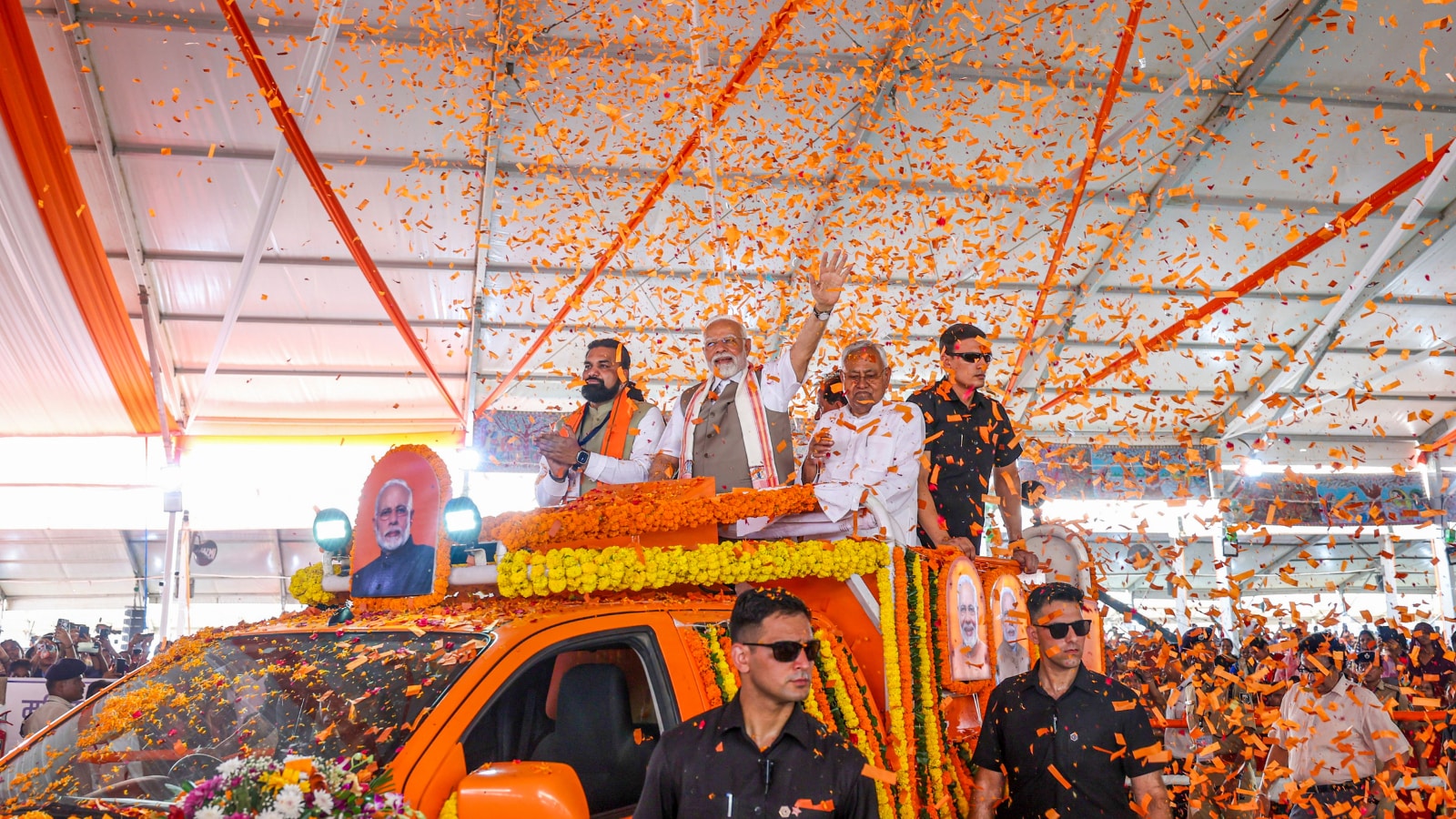Copyright news18

Last week, Prime Minister Narendra Modi visited Shri Harimandir Ji, Patna Sahib, following a massive roadshow in Patna and election rallies in Arrah and Nawada. Shri Harimandir Ji Patna Sahib, one of Sikhism’s five “takhts”, was commissioned by Maharaja Ranjit Singh in the 18th century to mark the birthplace of Guru Gobind Singh, who was born in Patna in 1666 and spent his early years there, before moving to Anandpur Sahib. PM Modi’s visit to Patna Sahib was not symbolism, but a reflection of his devout belief in the lofty teachings of Sikh gurus. Patna and Sikhism have a shared history and bond. Beyond optics, Modi’s rallies in Bihar last week showcase his effortless charisma, which was evident from the sheer groundswell of people, especially the womenfolk, who turned up in huge numbers, to listen to him. Speaking of Bihar elections, the NDA’s manifesto (Sankalp Patra) is about jobs, financial support to women and farmers, permanent housing, free ration, electricity and healthcare and establishment of medical colleges, among other things. NDA has promised to provide government jobs to over 1 crore people. The idea is to carry out a skill census and offer skill-based employment and establish mega skill centres in every district to position Bihar as a global-level training centre. Under the Mukhyamantri Mahila Rojgar Yojana, women will be provided financial assistance of Rs 2 lakh. The manifesto also promises to make 1 crore Lakhpati Didis. Further, under ‘Mission Crorepati’, efforts will be made to empower women entrepreneurs to become millionaires. Rs 10 lakh financial assistance will be provided to several underprivileged categories. NDA has vowed to constitute a high-level committee under the Supreme Court to assess the social and economic conditions of different castes among the backward classes and suggest appropriate measures to empower these castes. Under the PM-Kisan scheme, farmers will be provided financial assistance of Rs 9,000 annually, versus the earlier Rs 6,000 per annum. Aid for fisherfolk will also be increased from Rs 4,500 to Rs 9,000. Additionally, an investment of Rs 1 lakh crore in agriculture infrastructure and procurement at minimum support price (MSP) for all crops, including rice, wheat, pulses and corn, will happen. Plans to establish five mega food parks, double agricultural production, have self-reliance in pulses’ production by 2030 and develop Bihar as the global export centre for fish and foxnuts are on the anvil. Modernisation of seven expressways, 3,600 km of rail track, expansion of Amrit Bharat expressways and NaMo rapid rail, including launch of metro services in four cities, will empower Bihar, further. A ‘greenfield city’ in New Patna, satellite township in major cities and establishing Seetamarhi as an international spiritual city, are on the cards too. Establishing a greenfield international airport in Patna, three international airports in Darbhanga, Purnia and Bhagalpur and domestic flights in 10 new cities, are also part of the NDA manifesto. A mega Rs 1 lakh crore industrial development plan will lay the foundation for industrialisation and lakhs of jobs, with 10 industrial parks in every district. Free ration, 50 lakh new houses under PM Awas Yojana, free electricity up to 125 units, free healthcare up to Rs 5 lakh and social security pension, will redefine welfarism, the Modi way. Free education from kindergarten to post-graduation for poor, mid-day meal and breakfast in schools, skill labs and Rs 5,000 crore investment to revamp district-level schools, are set to be gamechangers. Establishing Bihar as South Asia’s textile and skill hub through Mithila Mega Textile and Design Park and skill park and establishing defence corridor, semi-conductor manufacturing park, global capability centres, mega tech city and fintech city, are all a part of NDA’s bigger plan to turn Bihar into a futuristic State. Establishment of medicity, medical college in every district, specialised super-speciality hospital, special schools for children with autism and plans to establish dedicated centre of excellence for specific games, are exactly the elixir Bihar needs. For Scheduled Caste (SC) category students, residential schools will be opened in every subdivision. A Rs 2,000 monthly assistance will also be given to SC students pursuing higher education. Assistance of up to Rs 10 lakh will be extended to those from the Extreme Backward Classes (EBC) category. Auto, taxi and e-rickshaw drivers will be given life insurance worth Rs 4 lakh. They will also be provided collateral-free vehicle loans at minimum interest rates. Establishment of Bihar School of Drama and Film and Television Institute and the intent to make the State flood-free in five years, are indeed, praiseworthy. Plans are afoot to construct river-linking projects, embankments and canals under the “flood to fortune” model, to promote agriculture and fisheries. Now contrast what the BJP-led NDA seeks to do, with the dark shadow of Lalu-Rabri’s erstwhile rule in Bihar for 15 long years, that still invokes palpable fear. The term “Jungle Raaj,” evoking an era of anarchy where the law of the jungle supplanted the rule of law, has become synonymous with that 15-year tenure of Lalu Prasad Yadav and his wife Rabri Devi as Chief Ministers of Bihar from 1990 to 2005. Coined by the Patna High Court in 1997 amid complaints of civic collapse and waterlogging in Patna—described as “worse than the Jungle Raaj”—the phrase quickly entered political lexicon. It encapsulates a period marked by rampant crime, economic stagnation, caste-based violence and criminalisation of politics, which devastated Bihar, once a cradle of ancient learning, into a State of despair. Under Lalu, Bihar devolved into what scholars like Arvind N Das termed a “Hobbesian” State—nasty, brutish and short. Crime statistics paint a grim picture: between 1990 and 2005, Bihar reported over 10,000 annual riots, with kidnappings surging 65.9 per cent in later years, though dacoity peaked earlier. The National Crime Records Bureau (NCRB) data showed Bihar’s crime rate consistently above the national average, with extortion, ransom demands and booth-capturing as election norms. Businesses fled the State; Patna’s once-thriving markets saw lootings, including jewellery shops being raided during Lalu’s daughter Misa Bharti’s 1999 wedding, to pay for Misa’s extravagance. Migration exploded, with millions of Biharis who sought work in Delhi and Mumbai, often facing exploitation, as local industries collapsed under extortion rackets, led by Lalu’s henchmen. Caste-based massacres epitomised the violence, turning Central Bihar into a “killing field,” as the Patna High Court lamented in 1997. At least 118 such incidents occurred, including the 1996 Bathani Tola massacre (21 Dalits killed by an upper-caste militia) and the 1997 Laxmanpur Bathe slaughter (58 deaths). These were retaliatory clashes between private armies of landowners and landless labourers, but Lalu’s administration favoured Lalu’s musclemen, exacerbating divisions. Bahubalis, aka criminal strongmen like Mohammad Shahabuddin (now dead), Anand Mohan and Prabhunath Singh—flourished, winning elections on RJD tickets. Shahabuddin, RJD MP from Siwan, amassed over 40 criminal cases, including murders and kidnappings; a 1997 intelligence report claimed Lalu patronised a third of Bihar’s 120 dacoit gangs. In 2001, his men fired on police in Siwan, underscoring State failure. His son Osama Shahab has been fielded by RJD in the upcoming assembly elections. High-profile incidents underscored the terror. On December 5, 1994, IAS officer G Krishnaiah was lynched in Muzaffarpur by a mob linked to Chhotan Shukla, a close Lalu associate. In 1998, Champa Biswas, wife of Dalit IAS officer BB Vishwas, was gang-raped by Lalu aide Mrityunjay Yadav and accomplices—her mother, niece, and maids were also raped – yet the case dragged on, without conviction. In the 1999 Shilpi-Gautam double murder, the bodies were found semi-nude in Sadhu Yadav’s (Rabri’s brother) guest house and it was ruled a “suicide” amidst a shameful cover of these gory murders by Lalu’s cohorts. Even politicians weren’t spared–MLAs Ajit Sarkar and Devendra Dubey, Minister Brij Bihari Prasad and many more were assassinated due to political rivalries with the Lalu clan, by RJD gangsters. Economic mismanagement compounded the chaos under Lalu and Rabri. Bihar’s per capita income plummeted to less than $110 by 2005, lower than sub-Saharan Africa’s average, with GDP growth near zero. Funds for development vanished into corruption; Lalu’s fodder scam, diverting Rs 950 crore from animal husbandry, led to his 1997 resignation and President’s rule. His wife, Rabri Devi’s proxy rule (1997-2005) saw administrative paralysis; teachers absent, roads crumbling and power outages routine. The State borrowed heavily but built little, earning the moniker “BIMARU” (sickly). RJD, in vain, has tried to counter that “Jungle Raaj” was just a politically weaponised slur by upper-caste elites resentful of OBC empowerment. But that is absolute balderdash. Jungle Raaj was not a figment of anyone’s imagination. It did exist with brazen impunity under the utterly corrupt Lalu-Rabri duo. Jungle Raaj, fortunately, came to an end in 2005 when the NDA ousted RJD. Under the NDA, former RJD gangsters and bahubalis were convicted, over 10,000 km of roads were built every single year, boosting GDP growth to over 10 per cent by 2010 and beyond. Ultimately, Jungle Raaj wasn’t mere chaos but a symptom of unchecked populism. Lalu weaponised power, prioritising corruption over governance. Lalu-Rabri years turned Bihar into a “mini-Somalia,” as many have argued, with its progress thwarted by a thoroughly violent RJD that came to symbolise vandalism, thuggery and daylight dacoity for the longest time. Coming back to the NDA, the greatest testament to PM Modi’s undying commitment to Bihar, beyond the infra boom under the NDA, is the resurrection of this culturally rich State’s historical legacy, by inaugurating the new campus of the Nalanda University at Rajgir, close to the site of the ancient ruins of Nalanda. The University aims to revive the ancient glory of Nalanda as an international institution for pursuit of intellectual, philosophical, historical and spiritual studies. The University also adds meaning to India’s ‘Act East’ Policy. The design and architectural elements of the new 455-acre campus, which is also a ‘Net Zero Green Campus’ and includes over 100 acres of water bodies (Kamal Sagar ponds), an on-grid solar plant, a domestic and drinking water treatment plant and a water recycling plant for reusing wastewater as well as over 100 acres of green cover, showcases the splendour of Bihar in all its glory. From launching the Makhana Board to the Buddhist Circuit Tourist train (Mahaparinirvan Express), the unstoppable Modi magic has weaved its way through Bihar, delivering on every single promise, ensuring this beautiful State unlocks its immense potential. Sanju Verma is an Economist, National Spokesperson of the BJP and the Bestselling Author of ‘The Modi Gambit’. Views expressed in the above piece are personal and solely those of the author. They do not necessarily reflect News18’s views



